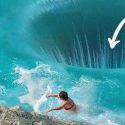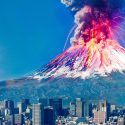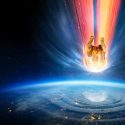No, that’s not Photoshop. That’s an actual video from the International Space Station of the Moon looking a bit squished. Wow, so what happened here? Is the cover-up behind a flat Moon an elaborate government conspiracy? How would this affect the oceans? What would happen to our climate? And could the Moon fly out into space?
In 2010 an astronaut on the ISS observed a bizarre phenomenon. When he glanced out the window, he saw the Moon looked flattened when it appeared in the thickest part of the Earth’s atmosphere. And those of you in the Flat Earth Society, don’t at me. It’s not flat. High above the planet, the air bends light to give the Moon this squished look in these very specific conditions.
But if the Moon were flat, it would explain why we never see the mysterious dark side. And if this was our reality, how would this affect gravity on Earth? OK, there are no illusions this time. The Moon is flat. So how would that happen? A celestial body would need to spin incredibly fast to become a flat disc. So fast that it would rip apart into tiny pieces before it would ever have a chance to form. For our purposes, let’s say the Moon survived this process and formed like a plate.
Would this flat Moon have the same mass as what we see right now? As a flat disc, the Moon could have 25% of the thickness, but the width might remain the same. With so much less mass floating above Earth, the change in ocean tides could be the first noticeable effect. The Moon’s gravitational pull generates these tides.
Our Moon pulls the water on the side of the Earth that’s closest to it. But this flat Moon would have less mass and less gravitational effect on our planet. So the altered tides would affect more than surfers. Ocean tides stir up material below the water’s surface, allowing coastal ecosystems to thrive. Without the usual strong waves, animal life in the oceans, like crabs, mussels and snails, could die off in mass numbers.
This chain reaction could decimate life worldwide. And that’s not all a flat Moon would ruin. Remember, the tides also push water back and forth around the planet. When warm waters travel from one area to another, these tidal forces change weather patterns globally. Without the strong tides, we could experience extreme temperature changes.
Even with all these devasting changes, the climate still wouldn’t change as fast as the days. The Moon’s mass influences our planet’s rotation, giving us a 24 hour day. But with a flat Moon, the day could be only 15 hours long. OK, I think most of us can live with a 5-hour workday. And while we’d get more sunlight, the nights would be even darker.
See, the Moon reflects the sunlight to give off that bright glow we all know and love. A smaller Moon would reflect less light, making it much dimmer. That would make it harder for nocturnal animals that rely on the Moon for navigation and hunting. Maybe none of that would matter since it could potentially crash right into us. Wait, what?
The Earth and the Moon are locked together in an eternal dance. The motion created by one affects the other. I know. This sounds hippy-dippy, but trust me, we’re talking science here. The same tidal forces that move the oceans also affect the Moon’s orbit. The tidal bulges in the ocean rotate faster than the Moon orbits the Earth. And this rotation takes energy away from the Earth and transfers that into the Moon’s orbit.
This is called tidal friction and causes the Moon to drift away from us at the rate of 3.82 cm (1.5 in) per/every year. A flat Moon with less mass would orbit closer to our planet. So maybe it wouldn’t slam into Earth. But our view of celestial phenomena wouldn’t be the same. Right now, the Sun and the Moon are positioned just perfectly that when aligned, we get a spectacular image of a total eclipse on Earth.
The Moon covers the Sun entirely in this breathtaking event. A squished Moon wouldn’t be able to block out the Sun entirely during an eclipse, and we would see the top and the bottom of the Sun peaking out. A flat Moon could destroy the balance of life on Earth and threaten every ecosystem and living organism, including humans. But what if the conspiracy theorists were right all along? What if the Earth was flat?
Sources
- “The Moon Illusion | Observe The Moon – Moon: NASA Science”. 2022. moon.nasa.gov.
- “The Moon Is Flat!”. Phil Plait. 2011. discovermagazine.com.
- “Moon Fact Sheet”. 2022. nssdc.gsfc.nasa.gov.
- “The Moon Is (Slightly) Flat, Scientists Say”. Douglas Quenqua. 2014. nytimes.com.
- “What Would Happen If The Moon Disappeared?”. 2022. rmg.co.uk.



























